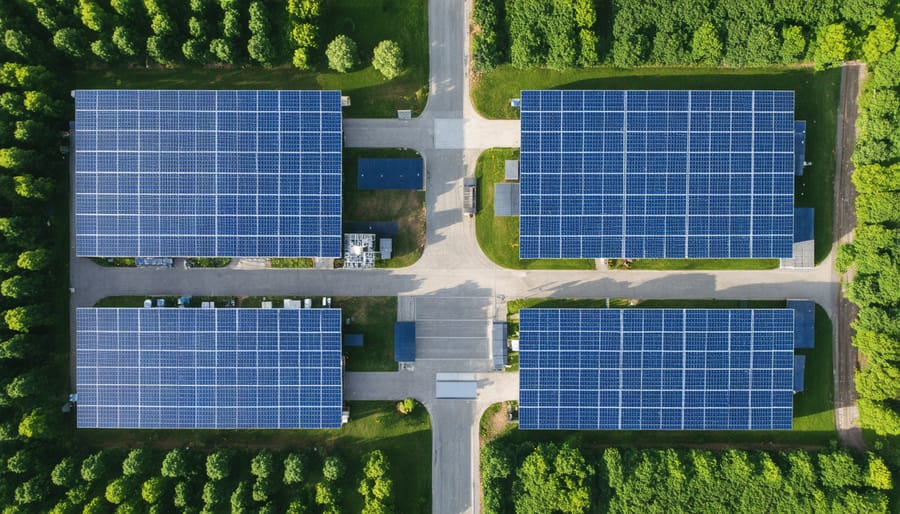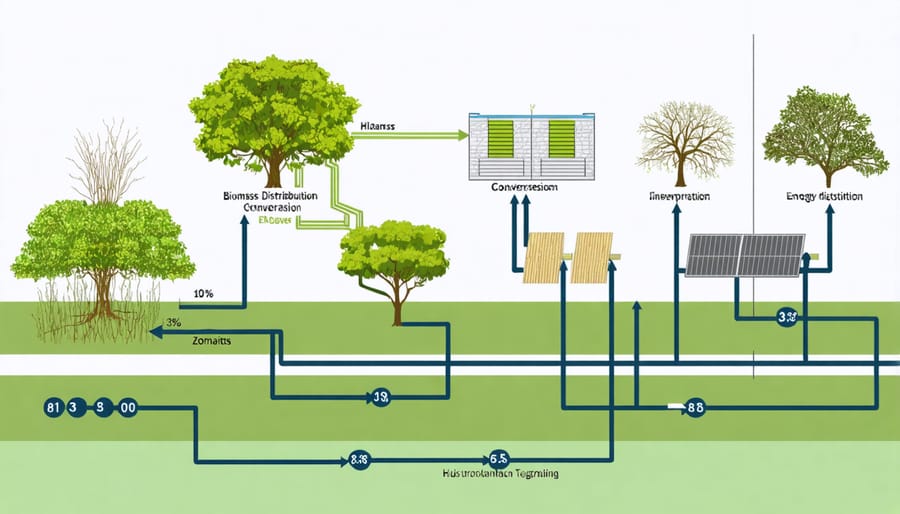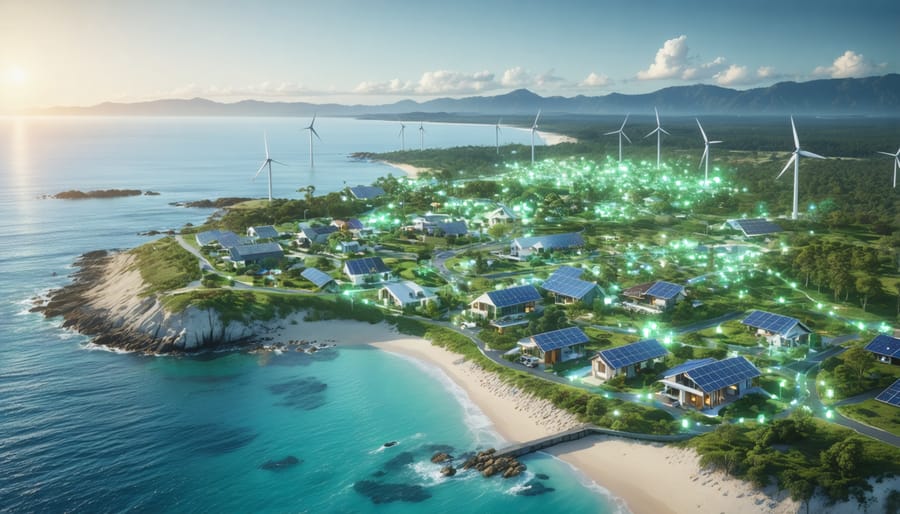In the face of increasingly unpredictable climate patterns and energy challenges, resilience zones are emerging as powerful solutions for Australian communities. These self-sustaining micro-grids combine local renewable energy sources, smart storage systems, and innovative distribution networks to ensure continuous power supply even when the main grid fails.
Imagine a neighborhood that keeps humming with electricity during a severe storm while surrounding areas go dark. That’s exactly what happened in the coastal town of Byron Bay, where Australia’s first community-led resilience zone demonstrated its worth during the 2022 floods. By integrating solar arrays, battery storage, and bioenergy facilities, this pioneering project not only maintained essential services but also reduced energy costs for residents by 32%.
Today, resilience zones represent more than just backup power systems – they’re becoming blueprints for Australia’s energy future. These innovative districts showcase how communities can take control of their energy destiny while contributing to national climate goals. From hospitals maintaining critical operations during emergencies to businesses avoiding costly shutdowns, resilience zones are transforming how we think about energy security in our sunburnt country.
What Makes a Community Energy Resiliency Zone?
Key Infrastructure Components
A resilient zone’s backbone consists of strategically integrated infrastructure components that work together to ensure reliable, sustainable power supply. At the heart of these systems lies the microgrid, a localised power network that can operate independently or in conjunction with the main grid. These microgrids typically incorporate renewable energy sources like solar panels and wind turbines, alongside sophisticated energy storage systems such as battery banks or pumped hydro facilities.
Bioenergy facilities play a crucial role, converting local organic waste into valuable power and heat. These facilities often feature anaerobic digesters or biomass boilers, providing a reliable baseload power source while addressing waste management challenges. Smart control systems and advanced monitoring equipment ensure these components work harmoniously, automatically adjusting to demand fluctuations and weather conditions.
Critical backup systems, including redundant power supplies and emergency generators, provide an additional layer of security. Communications infrastructure, including robust data networks and control centres, enables real-time monitoring and rapid response to any disruptions, ensuring the zone maintains its resilience even during challenging conditions.

Community Integration Elements
The social fabric of resiliency zones is woven through strong community partnerships and collaborative decision-making processes. At their core, successful community-based renewable energy initiatives rely on active participation from local residents, businesses, and institutions.
Key organizational structures typically include community energy cooperatives, local working groups, and advisory committees that ensure diverse representation and shared responsibility. These groups often partner with local councils, indigenous communities, and environmental organizations to create inclusive governance models that reflect the community’s needs and aspirations.
Regular community forums and workshops serve as vital platforms for knowledge sharing and capacity building. Many successful resiliency zones have established mentorship programs where experienced communities guide newer initiatives, creating a network of support across regions. Educational partnerships with local schools and TAFE institutions help build awareness and develop the skills needed for long-term sustainability.
Digital platforms and communication tools enable real-time coordination and transparent decision-making, while regular community events celebrate achievements and maintain momentum. This integrated approach ensures that resiliency zones remain responsive to community needs while building lasting social connections that strengthen local resilience.
Bioenergy’s Role in Building Resilient Communities

Local Resource Utilization
Local communities can maximize their resilience by effectively utilizing available biomass resources within their immediate surroundings. In Australia, this often includes agricultural waste, forest residues, and organic municipal waste. These materials can be transformed into valuable energy sources through various conversion processes, supporting both energy independence and waste reduction goals.
For example, sugar cane-growing regions in Queensland have successfully implemented bagasse-to-energy systems, where leftover plant material from sugar production powers local mills and feeds excess electricity back to the community grid. Similarly, dairy farms across Victoria are converting animal waste into biogas, providing both electricity and heating for their operations while reducing methane emissions.
Communities can conduct resource mapping exercises to identify potential biomass sources within their zone. This might include surveying local farms, food processing facilities, and timber operations to quantify available organic materials. Understanding seasonal variations in resource availability helps in planning sustainable year-round energy production.
Effective resource utilization also creates local employment opportunities and strengthens regional economies. Many communities have established cooperative arrangements where farmers, businesses, and waste management facilities work together to ensure steady biomass supply chains.
To maximize efficiency, communities should prioritize resources that are easily accessible and require minimal transportation. This approach not only reduces costs but also maintains a smaller carbon footprint, aligning with the core principles of resilience zone development.
Energy Security Benefits
In times of natural disasters or grid failures, resiliency zones powered by bioenergy serve as crucial lifelines for communities. By incorporating bioenergy systems, these zones maintain essential services and provide reliable backup power when traditional energy infrastructure fails.
During bushfire seasons or severe storms, bioenergy facilities can operate independently from the main grid, ensuring hospitals, emergency services, and community shelters maintain power. Unlike solar or wind energy, which depend on weather conditions, bioenergy systems can provide continuous power generation using locally sourced organic materials.
The Hepburn Shire in Victoria demonstrates this reliability perfectly. Their bioenergy facility, which processes agricultural waste and forest residues, has maintained power supply during several grid outages, keeping critical facilities operational. This included powering the local medical centre and emergency coordination facility during the 2019-20 bushfire season.
Beyond emergency situations, bioenergy systems contribute to everyday energy security by reducing dependence on imported fuels. Communities with established resiliency zones report significant improvements in their ability to maintain essential services during power disruptions, with some facilities capable of operating autonomously for weeks.
The flexibility of bioenergy systems also allows for quick scaling of power generation during peak demand periods or emergencies, providing communities with adaptable and dependable energy solutions when they need them most.
Success Stories: Australian Communities Leading the Way
Across Australia, communities are leading the charge in creating resilient, sustainable energy networks, with several successful community energy projects demonstrating the transformative power of resiliency zones.
The township of Yackandandah in Victoria stands as a shining example of community-driven energy independence. Through their initiative “Totally Renewable Yackandandah,” the community has established a sophisticated microgrid system incorporating solar panels, battery storage, and smart energy management. Their resiliency zone now powers over 55% of the town’s energy needs, with plans to reach 100% renewable energy by 2024.
In South Australia, the Sundrop Farms project showcases how resiliency zones can revolutionize agriculture. Their innovative system uses solar thermal technology and desalinated seawater to grow tomatoes in the desert. This self-sustaining facility produces over 15,000 tonnes of tomatoes annually while maintaining complete energy independence.
The Byron Bay Arts & Industry Estate has transformed into a thriving resiliency zone through the implementation of a community-owned solar network. Local businesses collaborated to install rooftop solar systems and smart meters, creating a shared energy network that reduces costs and strengthens community bonds.
The remote Indigenous community of Doomadgee in Queensland demonstrates how resiliency zones can empower isolated communities. Their hybrid solar and battery system has reduced diesel consumption by 70% while providing reliable power to 230 homes and essential services.
The Hepburn Wind project in Victoria, Australia’s first community-owned wind farm, forms the backbone of their local resiliency zone. The initiative powers over 2,000 homes and reinvests profits back into community development, creating a model of sustainable energy independence.
These success stories share common elements: strong community engagement, innovative technology integration, and a commitment to long-term sustainability. They prove that resiliency zones aren’t just theoretical concepts but practical, achievable solutions for communities of all sizes across Australia.
Building Your Community’s Resiliency Zone

Planning and Assessment
Developing a successful resiliency zone begins with comprehensive planning and thorough assessment of local resources and needs. Communities looking to take control of local energy must first conduct a detailed analysis of their current energy consumption patterns, available renewable resources, and infrastructure capabilities.
The initial assessment should identify key stakeholders, including local businesses, residents, and government bodies. This collaborative approach ensures all perspectives are considered and helps build community support from the outset. A crucial part of this process involves mapping existing energy assets and potential renewable energy sources, with particular attention to biomass availability and solar exposure.
Technical feasibility studies should evaluate grid connection points, energy storage options, and distribution networks. Environmental impact assessments must consider local biodiversity, water resources, and land use requirements. Economic modeling helps determine project viability and potential funding sources, including government grants and community investment schemes.
Risk assessment is another vital component, addressing potential challenges such as weather events, equipment failure, and market fluctuations. This information forms the foundation for developing robust contingency plans and maintenance schedules.
Finally, establishing clear metrics for success helps track progress and demonstrate value to stakeholders. These might include reduced outage times, cost savings, carbon emission reductions, and community engagement levels. Regular review and adjustment of these metrics ensures the resiliency zone remains effective and responsive to community needs.
Implementation Roadmap
Establishing a resiliency zone requires careful planning and a phased approach to ensure successful implementation. The journey typically begins with a comprehensive community assessment to identify local resources, needs, and potential challenges. This initial phase should take 3-6 months and involve extensive stakeholder consultation.
The second milestone involves securing necessary permits and developing partnerships with local utilities, government bodies, and key stakeholders. This phase usually spans 6-12 months and includes detailed technical assessments and feasibility studies.
Infrastructure development marks the third phase, typically lasting 12-24 months. This includes installing renewable energy systems, setting up microgrids, and establishing backup power solutions. For Australian communities, this often means integrating solar arrays, battery storage systems, and potentially bioenergy facilities.
Community engagement and training form a crucial fourth phase, running parallel to infrastructure development. This includes educating residents about energy conservation, emergency preparedness, and system maintenance. Local champions should be identified and trained to help manage the zone effectively.
The final implementation phase focuses on testing and optimization, usually taking 3-6 months. This involves conducting simulated emergency scenarios, fine-tuning systems, and establishing monitoring protocols.
Post-implementation, ongoing evaluation and adjustment ensure the resiliency zone remains effective and adapts to changing community needs. Regular community feedback sessions, system updates, and performance reviews help maintain optimal operation and community support.
As Australia continues to embrace sustainable energy solutions, resiliency zones stand as beacons of innovation and community empowerment. These self-sufficient energy hubs have demonstrated remarkable success in strengthening local communities while advancing our nation’s renewable energy goals. The proven benefits – from enhanced energy security and reduced power costs to improved disaster resilience and decreased carbon emissions – make a compelling case for their widespread adoption.
Looking ahead, the future of resiliency zones in Australia appears particularly promising. With technological advancements in energy storage, smart grid systems, and renewable generation becoming more accessible and affordable, communities across the country are increasingly well-positioned to establish their own resilient energy networks. The growing support from state and federal governments, coupled with rising community interest, suggests we’re on the cusp of a significant expansion in resiliency zone implementation.
The success stories from pioneer communities like Totally Renewable Yackandandah and the Daintree Microgrid Project are inspiring similar initiatives nationwide. These examples show that when communities come together with a shared vision for sustainability, remarkable transformations are possible. As climate challenges intensify, resiliency zones offer a practical, community-driven solution that aligns perfectly with Australia’s journey toward a sustainable future.
By continuing to invest in resiliency zones, we’re not just building energy infrastructure – we’re creating more resilient, connected, and sustainable communities for generations to come.

